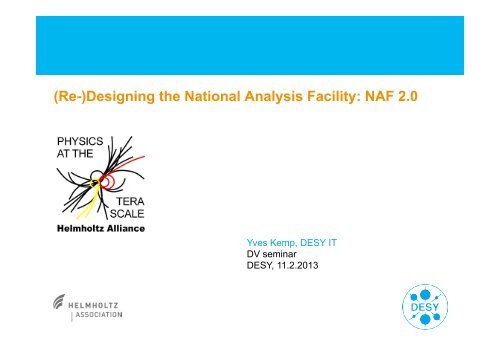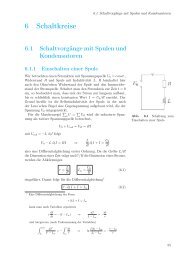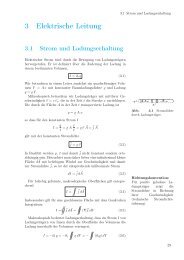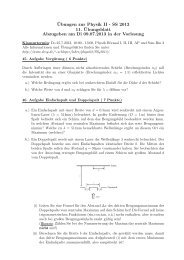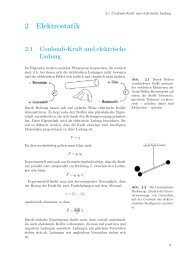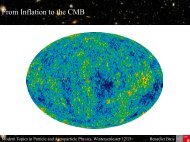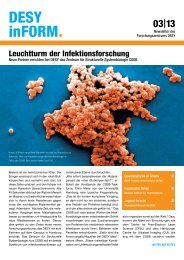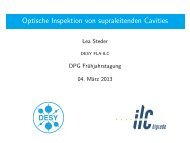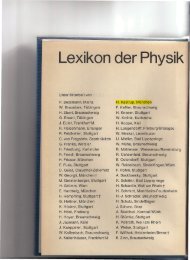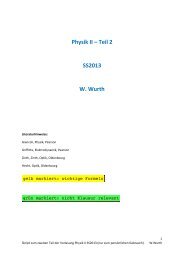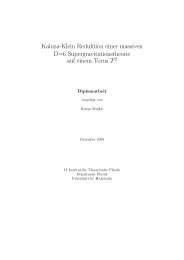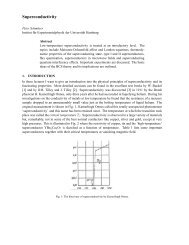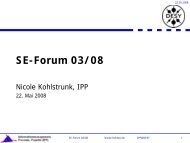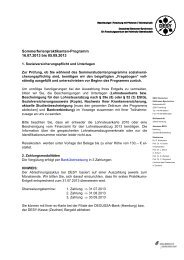(Re-)Designing the National Analysis Facility: NAF 2.0 - Desy
(Re-)Designing the National Analysis Facility: NAF 2.0 - Desy
(Re-)Designing the National Analysis Facility: NAF 2.0 - Desy
Create successful ePaper yourself
Turn your PDF publications into a flip-book with our unique Google optimized e-Paper software.
(<strong>Re</strong>-)<strong>Designing</strong> <strong>the</strong> <strong>National</strong> <strong>Analysis</strong> <strong>Facility</strong>: <strong>NAF</strong> <strong>2.0</strong><br />
Yves Kemp, DESY IT<br />
DV seminar<br />
DESY, 11.2.2013
Some history: The <strong>National</strong> <strong>Analysis</strong> <strong>Facility</strong> (<strong>NAF</strong>)<br />
> The Helmholtz Alliance “Physics at <strong>the</strong> TeraScale”<br />
started Mid 2007<br />
> One of its pillars was “<strong>Re</strong>search topic Grid<br />
Computing”<br />
> One of its projects was <strong>the</strong> “<strong>National</strong> <strong>Analysis</strong><br />
<strong>Facility</strong>”<br />
… complement <strong>the</strong> German Grid resources<br />
… interactive and analysis resources<br />
… to be used by members of German LHC (and ILC)<br />
institutes<br />
… starting at <strong>the</strong> two DESY locations<br />
> Started (according to my calendar) on 4.6.2007<br />
with a meeting with CMS users<br />
> LHC datataking: 10-19.9.2008 – since end 2009<br />
Yves Kemp | (<strong>Re</strong>)Disigning <strong>the</strong> <strong>NAF</strong>: <strong>NAF</strong> <strong>2.0</strong> | 11.2.2013 | Page 2
Some more history: Grid and Computing<br />
> 2001: European DataGrid project launched / dCache.org project officially launched<br />
> 2004: Foster/Kesselmann: The Grid: Blueprint for a new computing infrastructure<br />
> August 2004: DESY operates Grid infrastructure<br />
> 2005: LHC Computing TDR<br />
> 2006: 1&1 hosts ~25.000 server in Karlsruhe CC<br />
> 2006: Intel Dual-Core Systems are “state-of-<strong>the</strong>-art”, two-socket-systems<br />
> End 2010: LHC Computing Grid: ~200k CPU core, 150 PB data<br />
> End 2011: Amazon S3 ~550 PB data<br />
> 2012: Amazon EC2 largest CC (Virginia) ~5k Racks . 150k-330k Server<br />
> 2012: Facebook initial public offer: 104.000.000.000 USD<br />
Yves Kemp | (<strong>Re</strong>)Disigning <strong>the</strong> <strong>NAF</strong>: <strong>NAF</strong> <strong>2.0</strong> | 11.2.2013 | Page 3
The Mobile <strong>Re</strong>volution<br />
Mobile Computing in 2007 Mobile Computing in 2013<br />
... Is this of relevance for <strong>NAF</strong> people?<br />
… Yes, it is: Influences people and technology<br />
Yves Kemp | (<strong>Re</strong>)Disigning <strong>the</strong> <strong>NAF</strong>: <strong>NAF</strong> <strong>2.0</strong> | 11.2.2013 | Page 4
Getting back to <strong>the</strong> <strong>NAF</strong><br />
> How did <strong>the</strong> <strong>NAF</strong> came to life?<br />
> DESY IT (Hamburg) and DV (Zeu<strong>the</strong>n) created a <strong>NAF</strong> project group<br />
> We asked <strong>the</strong> experiments for requests<br />
<strong>Re</strong>ceived by ATLAS, CMS and LHCB<br />
Can be found at http://naf.desy.de/nuc/<br />
> We had several discussion workshops, both internally and with<br />
experiments<br />
> … let’s have a look at what people asked for – five years ago<br />
Yves Kemp | (<strong>Re</strong>)Disigning <strong>the</strong> <strong>NAF</strong>: <strong>NAF</strong> <strong>2.0</strong> | 11.2.2013 | Page 5
Yves Kemp | (<strong>Re</strong>)Disigning <strong>the</strong> <strong>NAF</strong>: <strong>NAF</strong> <strong>2.0</strong> | 11.2.2013 | Page 6
Yves Kemp | (<strong>Re</strong>)Disigning <strong>the</strong> <strong>NAF</strong>: <strong>NAF</strong> <strong>2.0</strong> | 11.2.2013 | Page 7
Yves Kemp | (<strong>Re</strong>)Disigning <strong>the</strong> <strong>NAF</strong>: <strong>NAF</strong> <strong>2.0</strong> | 11.2.2013 | Page 8
What part of <strong>the</strong> <strong>NAF</strong> concept is not in <strong>the</strong> previous sketch?<br />
> <strong>Re</strong>quirement: Minimal dependency of DESY infrastructure<br />
Not sure whe<strong>the</strong>r <strong>NAF</strong> would be limited to DESY – actually expansion plan to<br />
o<strong>the</strong>r sites<br />
<strong>National</strong> instrument, not a DESY one – make this clear in <strong>the</strong> infrastructure<br />
Many new, non-DESY based user with no connection to DESY<br />
New scale – not sure if feasible in DESY infrastructure in 2007<br />
> Lead to: Ra<strong>the</strong>r independent <strong>NAF</strong> infrastructure<br />
Independent user registration, based on X.509 Grid certificates<br />
Independent software stack (independent installation and configuration system)<br />
Independent support channels<br />
...<br />
Not independent: in DESY CC, using <strong>the</strong> same network, <strong>the</strong> same people, …<br />
Yves Kemp | (<strong>Re</strong>)Disigning <strong>the</strong> <strong>NAF</strong>: <strong>NAF</strong> <strong>2.0</strong> | 11.2.2013 | Page 9
The support model: A split one<br />
> The provider know <strong>the</strong>ir infrastructure<br />
They will help users with problems <strong>the</strong>re<br />
> Who is “<strong>the</strong>y”?<br />
General helpdesk as a first-level-support – entry point for normal users<br />
Different expert groups in <strong>the</strong> second-level – not directly accessible to normal users<br />
> The experiments know about <strong>the</strong>ir software and <strong>the</strong>ir internal workflows<br />
They will help users with problems <strong>the</strong>re<br />
> Who is “<strong>the</strong>y”? (… my view as an outsider to <strong>the</strong> experiments … )<br />
German VO support group – experts as a first-level-support<br />
Global VO support channels in <strong>the</strong> second-level<br />
Yves Kemp | (<strong>Re</strong>)Disigning <strong>the</strong> <strong>NAF</strong>: <strong>NAF</strong> <strong>2.0</strong> | 11.2.2013 | Page 10
<strong>NAF</strong> 1.0: How did it go?<br />
> Fast setup, many users, many successful analyses. General setup OK.<br />
> Identified some weak points though:<br />
Missing integration into “normal” DESY proved to be manpower intensive and decoupled<br />
<strong>NAF</strong> from advances in “normal” DESY infrastructure<br />
A fur<strong>the</strong>r spread to o<strong>the</strong>r sites in Germany did not happen<br />
We never benefited from <strong>the</strong> two-site setup – actually, we suffered from it in terms of<br />
reliability and performance (latency!)<br />
> Needs have evolved since 2007<br />
More graphical tools needed<br />
More software, e.g. also commercial one<br />
General mobility ask for better remote capabilities<br />
> The <strong>NAF</strong> needs a fundamental redesign to continue its success story<br />
Yves Kemp | (<strong>Re</strong>)Disigning <strong>the</strong> <strong>NAF</strong>: <strong>NAF</strong> <strong>2.0</strong> | 11.2.2013 | Page 11
<strong>NAF</strong> 1.0: Login using Certificates<br />
> In 2007: Integrate <strong>NAF</strong> with Grid<br />
It was clear that Grid certificates must play a role<br />
Grid certificates chosen as <strong>the</strong> only au<strong>the</strong>ntication method – no password<br />
Lead to gsissh – worked well in <strong>the</strong> <strong>NAF</strong> 1.0 context<br />
> Since 2007: Adoption of Grid certificates (or X.509 in general) has not<br />
increased<br />
Gsissh not integrated into normal OpenSSH distribution<br />
New communities not using X.509 (Photon)<br />
No interest from commercial vendors to equip <strong>the</strong>ir tools with X.509<br />
> Need for graphical login methods:<br />
NX or <strong>the</strong> like<br />
Works well – if you have username+password <br />
Yves Kemp | (<strong>Re</strong>)Disigning <strong>the</strong> <strong>NAF</strong>: <strong>NAF</strong> <strong>2.0</strong> | 11.2.2013 | Page 12
<strong>NAF</strong> 1.0: Detailed look at networking<br />
> The two-site setup had as an effect that most disturbances at on site had<br />
repercussions on <strong>the</strong> o<strong>the</strong>r site and <strong>the</strong> <strong>NAF</strong> as a whole<br />
Only a very small number of services were deployed in a redundant way<br />
> Investigation on latency effects on dCache NFS 4.1 mounts for ROOT file<br />
access: Lab emulation of latency<br />
Ping times:<br />
HH-WN -> HH-dCache<br />
ZN-dCache<br />
~ 5.5. ms<br />
<strong>Re</strong>ading files over WAN using dCache NFS v4.1<br />
Job duration [s]<br />
Hamburg<br />
Application type:<br />
Zeu<strong>the</strong>n<br />
Aachen<br />
Karlsruhe<br />
Munich<br />
Delay [ms]<br />
Yves Kemp | (<strong>Re</strong>)Disigning <strong>the</strong> <strong>NAF</strong>: <strong>NAF</strong> <strong>2.0</strong> | 11.2.2013 | Page 13
<strong>NAF</strong> 1.0: Is distributed access really needed?<br />
> 3 out of 4 VOs concentrated at one single site:<br />
ILC/Calice: Data only in DESY-HH (dCache and Lustre)<br />
LHCb: Data only in DESY-ZN (dCache and Lustre)<br />
CMS: Data only in DESY-HH (dCache and Lustre)<br />
> A look at <strong>the</strong> ATLAS case:<br />
Data stored on dCache in HH and ZN – ATLAS uses spacetoken, (simplifies): One for<br />
“official data” and one for “local data”.<br />
Only <strong>the</strong> latter one is used from <strong>the</strong> <strong>NAF</strong>. Job submission tools already now specify HH<br />
or ZN workernodes when accessing “local data” at HH or ZN resp.<br />
Data stored both in Lustre at HH and ZN. Lustre <strong>the</strong> only case for cross-site access<br />
But: Lustre (and successor Sonas in HH) meant to be fast local file systems<br />
Decision to mount Sonas only in Hamburg<br />
> Distributed access only necessary in some rare cases – and <strong>the</strong>n it is<br />
not optimal use of resoures<br />
Yves Kemp | (<strong>Re</strong>)Disigning <strong>the</strong> <strong>NAF</strong>: <strong>NAF</strong> <strong>2.0</strong> | 11.2.2013 | Page 14
<strong>NAF</strong> <strong>2.0</strong>: How? A very broad picture (oversimplified)<br />
DESY<br />
HH site<br />
- Batch system<br />
- AFS cell<br />
- Application support<br />
- Support team<br />
<strong>NAF</strong> “as is”<br />
- <strong>Re</strong>gistry<br />
- AFS cell<br />
- Application support<br />
- Support team<br />
DESY<br />
ZN site<br />
- Batch system<br />
- AFS cell<br />
- Application support<br />
- Support team<br />
(in reality <strong>the</strong> two DESY sites are not as separated as shown here)<br />
Yves Kemp | (<strong>Re</strong>)Disigning <strong>the</strong> <strong>NAF</strong>: <strong>NAF</strong> <strong>2.0</strong> | 11.2.2013 | Page 15
<strong>NAF</strong> <strong>2.0</strong>: How? A very broad picture (oversimplified)<br />
DESY<br />
HH site<br />
- Batch system<br />
- AFS cell<br />
- Application support<br />
- Support team<br />
<strong>NAF</strong> <strong>2.0</strong><br />
HH part<br />
<strong>NAF</strong> <strong>2.0</strong> common<br />
- <strong>Re</strong>gistry interface<br />
DESY<br />
ZN site<br />
- Batch system<br />
- AFS cell<br />
- Application support<br />
- Support team<br />
(in reality <strong>the</strong> two DESY sites are not as separated as shown here)<br />
<strong>NAF</strong> <strong>2.0</strong><br />
ZN part<br />
Yves Kemp | (<strong>Re</strong>)Disigning <strong>the</strong> <strong>NAF</strong>: <strong>NAF</strong> <strong>2.0</strong> | 11.2.2013 | Page 16
Future of <strong>the</strong> <strong>NAF</strong>: <strong>NAF</strong> <strong>2.0</strong> - What? _ 1<br />
> Everyone will get a “normal” DESY account<br />
> Will have access to a restricted set of “normal” DESY resources<br />
The <strong>NAF</strong> <strong>2.0</strong> resources<br />
Including several WGS<br />
Including large batch system<br />
Including $LargeFileStore (e.g. Sonas)<br />
Including dCache access<br />
…<br />
> Technical details:<br />
Closer integration into respective site (HH or ZN)<br />
No data should go over <strong>the</strong> WAN<br />
This is enforced in case of $LargeFileStore<br />
Plain ssh+Password login – gsissh planned for later<br />
Yves Kemp | (<strong>Re</strong>)Disigning <strong>the</strong> <strong>NAF</strong>: <strong>NAF</strong> <strong>2.0</strong> | 11.2.2013 | Page 17
Future of <strong>the</strong> <strong>NAF</strong>: <strong>NAF</strong> <strong>2.0</strong> - What? _ 2<br />
> Support: Better integrated into site support, so more people know <strong>the</strong><br />
infrastructure<br />
> New developments<br />
Ability to use DESY maintained software products<br />
Graphical login (“NX”-like, using StarNet X-Win32/LIVE technology)<br />
GridFTP access to Sonas planned<br />
Support for new communities: BELLE<br />
…<br />
> The ATLAS case:<br />
ATLAS is distributed over two sites, would lose a homogeneously looking system.<br />
Decision: Expand resources at HH-site to offer full <strong>NAF</strong> capabilities at a single site (Storage,<br />
dCache & CPU)<br />
Expansion will start in early 2013<br />
Role of ZN-site will probably evolve to resource and support provider for local ATLAS group<br />
Yves Kemp | (<strong>Re</strong>)Disigning <strong>the</strong> <strong>NAF</strong>: <strong>NAF</strong> <strong>2.0</strong> | 11.2.2013 | Page 18
<strong>NAF</strong> <strong>2.0</strong>: Broad overview of one site<br />
DESY<br />
People<br />
only<br />
DESY and<br />
external<br />
people<br />
ssh<br />
ssh<br />
“NX”-like<br />
Bastion<br />
Pub.ifh.de<br />
<strong>NAF</strong>-VO1<br />
WGS<br />
<strong>NAF</strong>-VO2<br />
WGS<br />
<strong>NAF</strong>-X<br />
“<strong>Re</strong>mote<br />
Desktop”<br />
ssh<br />
ssh<br />
DESY<br />
Desktop<br />
ssh<br />
qsub<br />
Private<br />
WGS<br />
Fast network, high BW,<br />
low latency<br />
Site NN<br />
Storage: dCache,<br />
Lustre, Sonas, AFS,<br />
NFS, ...<br />
Site NN<br />
General purpose<br />
Batch farm<br />
Machine<br />
Control<br />
Yves Kemp | (<strong>Re</strong>)Disigning <strong>the</strong> <strong>NAF</strong>: <strong>NAF</strong> <strong>2.0</strong> | 11.2.2013 | Page 19<br />
DESY<br />
internal<br />
machines
Current status in Hamburg:<br />
> Workgroupserver:<br />
ATLAS, CMS, ILC, BELLE – HeraFitter project to join<br />
Some SL5, o<strong>the</strong>rs SL6 – depending on whishes of <strong>the</strong> VO (all 64bit)<br />
Accessible from outside – IT managed<br />
> Batch facility:<br />
Hamburg site general purpose batch farm BIRD is used<br />
Some new nodes purchased in <strong>NAF</strong> <strong>2.0</strong> context, some out-ofwarranty<br />
machines from Grid cluster used for transition period<br />
Mixture of SL5 (~1500 cores) and SL6 (~200 cores)<br />
> Storage:<br />
dCache setup and access will stay untouched<br />
AFS: Using <strong>the</strong> DESY cell /afs/desy.de<br />
Lustre & Sonas: see later<br />
Yves Kemp | (<strong>Re</strong>)Disigning <strong>the</strong> <strong>NAF</strong>: <strong>NAF</strong> <strong>2.0</strong> | 11.2.2013 | Page 20
Current status in Zeu<strong>the</strong>n<br />
> A reminder: Decision: Expand resources at HH-site to offer full<br />
<strong>NAF</strong> capabilities at a single site (Storage, dCache & CPU)<br />
> The <strong>NAF</strong> <strong>2.0</strong> concept will however be used for local groups (Zeu<strong>the</strong>n and<br />
Humboldt e.g.)<br />
> Workgroupserver exists for local ATLAS group<br />
> 192 CPU cores in local Zeu<strong>the</strong>n batch farm<br />
> 120 TB Lustre space<br />
> 550 TB in ATLAS local group disk<br />
This space will probably not be expanded in future. The HH local<br />
group disk space token will serve as <strong>the</strong> main <strong>NAF</strong> <strong>2.0</strong> dCache space<br />
Yves Kemp | (<strong>Re</strong>)Disigning <strong>the</strong> <strong>NAF</strong>: <strong>NAF</strong> <strong>2.0</strong> | 11.2.2013 | Page 21
Status: Getting an account<br />
> Prerequisite for getting an account: Being known at DESY as a person<br />
> We need to enter you in PIP system: PersonenInformationsPool<br />
Name, Firstname, Affilitation, Date&Place of birth, … and this needs to be accurate,<br />
unique and somewhat certified<br />
> DESY people (or Uni-HH, Humboldt Uni and o<strong>the</strong>r befriended institutes)<br />
You are already registered in PIP !<br />
Your normal DESY account (<strong>the</strong> one you use for bastion.desy.de) just needs <strong>the</strong><br />
resource “batch” in <strong>the</strong> registry – and <strong>the</strong>re you go<br />
Already some (DESY-based) brave test users – Thank you!<br />
> External people<br />
You need to get registered in PIP<br />
Currently setting up a registration where you can enter all needed information – certified<br />
by your Grid certificate that you have in your browser<br />
The PIP entry and <strong>the</strong> account creation is <strong>the</strong>n done “automagically”<br />
We expect <strong>the</strong> first sketch of <strong>the</strong> system latest end of February<br />
Yves Kemp | (<strong>Re</strong>)Disigning <strong>the</strong> <strong>NAF</strong>: <strong>NAF</strong> <strong>2.0</strong> | 11.2.2013 | Page 22
… a side remark on <strong>the</strong> PIP issue<br />
> This underlines <strong>the</strong> new role of DESY<br />
> More and more people use only some DESY resources for a restricted<br />
time<br />
HERA times: Lots of external people – but ra<strong>the</strong>r long and intense usage of resources<br />
Photon science: Very mobile community, usage of many light-sources<br />
> Secure, au<strong>the</strong>nticated and authorized (and easy) access to computing<br />
important!<br />
Cannot expect people to fill in a paper form and hand it in in person somewhere at<br />
DESY<br />
Yves Kemp | (<strong>Re</strong>)Disigning <strong>the</strong> <strong>NAF</strong>: <strong>NAF</strong> <strong>2.0</strong> | 11.2.2013 | Page 23
When / how should users migrate?<br />
> <strong>NAF</strong> <strong>2.0</strong> is not yet fully operational<br />
> Most parts can however already now being used<br />
Depending on exact workflows, everything might be covered by <strong>NAF</strong> <strong>2.0</strong> already now<br />
> If you are brave, you can/should try out now – contact your VO<br />
representative!<br />
> We expect a larger migration to <strong>NAF</strong> <strong>2.0</strong> after <strong>the</strong> winter conferences<br />
> There will be a coexistence <strong>NAF</strong> 1.0 and <strong>NAF</strong> <strong>2.0</strong><br />
Details discussed with <strong>NAF</strong> Users Committee<br />
> … but our plan is to shutdown <strong>NAF</strong> 1.0 in 2013 !<br />
Yves Kemp | (<strong>Re</strong>)Disigning <strong>the</strong> <strong>NAF</strong>: <strong>NAF</strong> <strong>2.0</strong> | 11.2.2013 | Page 24
Lustre / Sonas and migration of data<br />
> Lustre in HH: … will fade away with <strong>NAF</strong><br />
1.0 (or even before)<br />
> Sonas in HH: Successor of Lustre<br />
Parts are mounted in <strong>NAF</strong> 1.0<br />
O<strong>the</strong>r parts are mounted in <strong>NAF</strong> <strong>2.0</strong><br />
… cannot mount <strong>the</strong> same part in both <strong>NAF</strong>: UID<br />
clashes (NFS v3 mount and security)<br />
> Migration:<br />
Sonas organized in “filesets”, e.g. each user has<br />
an own fileset<br />
Can migrate one fileset at a time<br />
… but it is ei<strong>the</strong>r <strong>NAF</strong> 1.0 or <strong>NAF</strong> <strong>2.0</strong><br />
… a problem for e.g. group filesets – <strong>the</strong>se will<br />
probably need to be copied and provided twice<br />
Lustre migration: e.g. copy (scp) Lustre@<strong>NAF</strong>1.0<br />
to Sonas@<strong>NAF</strong><strong>2.0</strong><br />
Yves Kemp | (<strong>Re</strong>)Disigning <strong>the</strong> <strong>NAF</strong>: <strong>NAF</strong> <strong>2.0</strong> | 11.2.2013 | Page 25
... No IT talk nowadays without talking about “The Cloud”<br />
DESY desktop<br />
on DESY LAN<br />
Notebook on<br />
DESY WLAN<br />
Notebook at<br />
home<br />
Tablet PC in<br />
<strong>the</strong> train<br />
Network:<br />
different<br />
quality<br />
levels<br />
Access<br />
Gateways<br />
Access<br />
Gateways<br />
“DESY HH <strong>Analysis</strong> Cloud”<br />
- Storage<br />
- CPU (Interactive, Batch, HPC, …)<br />
- Fast network, high BW, low latency<br />
Controlled network:<br />
Latency & limited BW<br />
“DESY ZN <strong>Analysis</strong> Cloud”<br />
- Storage<br />
- CPU<br />
- Fast network<br />
Yves Kemp | (<strong>Re</strong>)Disigning <strong>the</strong> <strong>NAF</strong>: <strong>NAF</strong> <strong>2.0</strong> | 11.2.2013 | Page 26
Summary and Outlook<br />
> <strong>NAF</strong> 1.0 was (and is) a success<br />
But <strong>the</strong> world has changed – need a redesign to continue success story<br />
> <strong>NAF</strong> <strong>2.0</strong> is partially <strong>the</strong>re right now<br />
… if you are brave, you can/should try it now!<br />
Plan to migrate to <strong>NAF</strong> <strong>2.0</strong> in 2013 – and shutdown <strong>NAF</strong> 1.0<br />
Well on track – missing parts being worked on right now!<br />
> <strong>NAF</strong> <strong>2.0</strong> a blueprint for communities beyond HEP? YES!<br />
Yves Kemp | (<strong>Re</strong>)Disigning <strong>the</strong> <strong>NAF</strong>: <strong>NAF</strong> <strong>2.0</strong> | 11.2.2013 | Page 27


